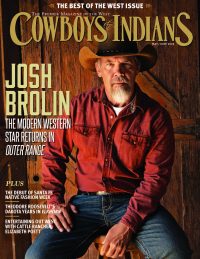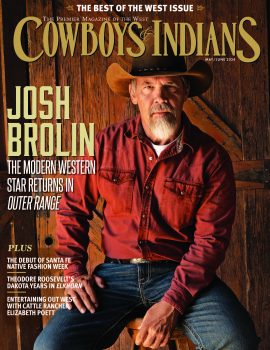With horseback riding, archery, fishing, zip-lining, ropes courses, and more, this summer camp in the Texas Hill Country offers camaraderie and outdoors fun to kids living with physical challenges and chronic illness.
Seven kids, ranging in age from 7 to 9, are clopping around the arena on horseback in a game of “musical stalls” to the accompaniment of the novelty Eurodance version of “Cotton Eye Joe” when a boy raises an arm, bull-rider-style, and boasts, “I’m only using one hand.” Halfway through the next lap, as if in reply, his mount pauses to expel a pile of manure.
The boy, Kaylan Fields, doesn’t hesitate to take credit on his next pass. “I hit the poop button,” he says with a grin.
A short walk away, boys and girls swim and splash each other, taking turns diving or sending up plumes of water with cannonballs and jackknives. Elsewhere, campers learn archery, make crafts, climb on a ropes course, zip-line, fish, kayak, or just sit and chat. They could be scenes from any summer camp, but Camp John Marc is no ordinary summer camp.
Camp John Marc, nestled in 170 acres of beautiful ranch land in Bosque County at the northern tip of the Texas Hill Country, is the host of 11 weeklong camps each summer, with each week dedicated to campers living with a different chronic illness or physical challenge in partnership with a corresponding hospital or advocacy organization. On top of summer camps, the facility offers weekend camps and family getaways in the fall, winter, and spring.
One week during the summer, the cabins are filled with children who have cancer. Other weeks will serve pediatric burn survivors or campers with chronic asthma, sickle cell disease, muscular dystrophy, or spina bifida. Cook Children’s Medical Center in Fort Worth, Texas, and Children’s Health, Texas Scottish Rite Hospital, and Parkland Memorial Hospital in Dallas have partnerships with the camp.
This week Camp John Marc is hosting Camp Moss, dedicated to campers with heart conditions. Some have had transplants, and others are on a waiting list for their own. In fact, the campgrounds even have a helipad in case a donor heart becomes available and a camper who is a potential recipient must be flown out for the operation. Pediatric cardiology specialists keep tabs on kids at the medical building, the hub of the camp that’s also lovingly referred to as the “Band-Aid Box,” “Med Shed,” and “Quack Shack.”

These kids, even the ones enduring those awkward adolescent years when seemingly everything is a potential embarrassment, don’t shy away from talking about their conditions. The swimmers don’t hide the pale operation scars that zipper up their torsos. For new Camp John Marc attendees, it might be the first time they’ve been around other kids living with the same condition. Back home at school, they can feel isolated by their health challenges, singled out in PE or recess, or treated as curiosities. Here, they’re what every kid, at one point or another, has desperately wanted to be: typical.
The camp was built on land donated by Marc and Jan Myers in honor of their outdoors-loving son, John Marc, who died of bone cancer at age 9 in 1987. With donations from an array of charitable organizations and family foundations, workers broke ground on the camp in 1990. The love and care shows in its construction. The late Juan Herrera and several of his sons built impressive stonework cabins from local materials. Texas artist Richard Wincorn hand-carved their doors with tree designs and emblems.
Camp John Marc accepted its first campers in 1991, a year and a half after its groundbreaking. Original executive director Vance Gilmore, an outdoors lover and camping-industry professional, welcomed nearly 500 chronically ill campers during the eight weeks of Camp John Marc’s first summer.
Current executive director Kevin Randles has been a fixture almost from the start, beginning as a camper himself from 1992 to 2000. Randles was diagnosed with acute lymphoblastic leukemia as a child growing up in the small town of Pottsboro, Texas.
“I was the only kid in my hometown who had it, so it was really nice to interact with other kids who were going through the same thing,” he says. “I’m still in contact with kids I met when we were six, seven, eight years old.”
Like many of the camp’s counselors and full-time staff, he transitioned to leadership positions as an older camper and then as a counselor, then joined the program staff full time in 2009 after graduating from college. Gilmore handed the reins to Randles in 2015.

Talk to a few current campers and you’ll get the impression that many want to follow in Randles’ footsteps. Jacob has come to Camp John Marc every year since 2012. He is 14 but looks much younger, his growth impeded by a weak heart. However, he talks with the assurance of a natural leader. Regular camp activities (he particularly likes archery and fishing), camaraderie with other kids living with heart conditions, trained staff, and a top-notch medical center make for a fun environment where kids feel welcome and safe.
“I’m here with people who have stuff like me,” he says. “They act like nothing’s wrong with me. Like yesterday, I got a cut getting ready for a cookout. I was scared because my brother had to get stitches, so I asked one of the counselors, ‘Am I OK?’ He said, ‘You’re fine.’ I said, ‘Are you sure?’ and he said, ‘I’m a doctor.’ ”
Keaton, 17 at the time of his camp week and in a leadership position that puts him somewhere between camper and counselor, says hanging out with friends and freedom from constant hospital checkups draw him back year after year. Succeeding in camp activities made him feel more capable and confident. In fact, he discovered that he enjoys archery so much that he now practices at a shooting range back home in Amarillo, Texas.
His friend and fellow teen leader-camper Nicolas agrees.
“It makes you feel much more able than I thought I was,” he says. “At first I was doing crafts with the girls while the guys were playing sports.” Socializing has also made him more confident. “Even though I’m a big guy, I used to be shy around people I don’t know,” he says. “I’ve gotten a lot more open, like, ‘Hey, what’s your name? What’s up?’”
Kid after kid describes similar experiences with their first day of camp. Just about anyone who’s gone to summer camp can probably relate to the early shyness, homesickness, and wariness of outdoor activities giving way to tearful goodbyes on the last day of camp and excitement to do it again next year.
That was the case for Jozie, 17, a longtime camper who is now taking on counselor responsibilities.
“I was very nervous my first year,” she says. “I didn’t know much about it, but when I got here, it was fantastic. There’s a welcoming, family feel to it.”
Jozie particularly likes boats, archery, and the ropes course, which is designed to challenge campers of all skill levels and abilities. With help and determination, one kid with muscular dystrophy made it to the top in 25 minutes — all for the reward of a zip-line ride. (The zip-line is also accessible to kids in wheelchairs, which can be hoisted up for a ride.)
Now a wrangler for equine activities, Erin Van Pelt, 25, first came to Camp John Marc as a camper in 2003. She was shy and self-conscious of her scars from staph infections, but by meeting kids with similar scars and medical conditions, she gained confidence.
“I loved it,” Van Pelt says. “I looked forward to it every summer and was very close to a group of girls I came with. Some of the people I came with as campers are back with me now.”
She says one of the most rewarding parts of her job is helping kids with mobility issues enjoy horseback riding. The stable has an electronic lift to help them into the saddle, and volunteers will walk alongside riders to make sure they stay on.
“Putting them on a horse is incredible,” she says. “It’s especially rewarding to see them get to do stuff that, quote-unquote, typical kids get to do.”
Find out more about Camp John Marc and how to help at campjohnmarc.org.













